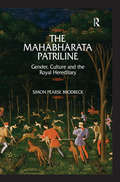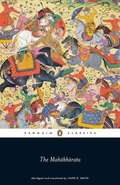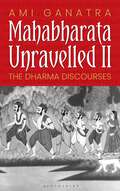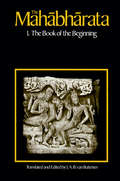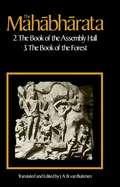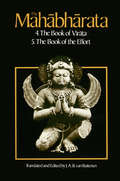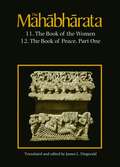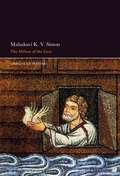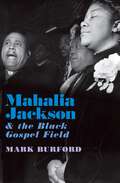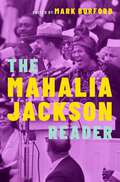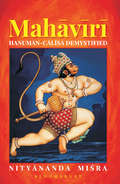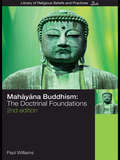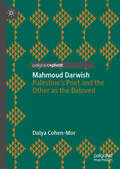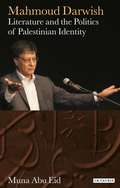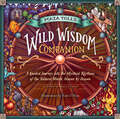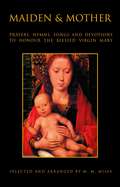- Table View
- List View
The Mahabharata Patriline: Gender, Culture, and the Royal Hereditary
by Simon Pearse BrodbeckThe Sanskrit Mahabharata (which contains the Bhagavad Gita) is sorely neglected as a classic - perhaps the classic - of world literature, and is of particularly timely human importance in today's globalised and war-torn world. This book is a chronological survey of the Sanskrit Mahabharata's central royal patriline - a family tree that is also a list of kings. Brodbeck explores the importance and implications of patrilineal maintenance within the royal culture depicted by the text, and shows how patrilineal memory comes up against the fact that in every generation a wife must be involved, with the consequent danger that the children might not sustain the memorial tradition of their paternal family. The Mahabharata Patriline bridges a gap in text-critical methodology between the traditional philological approach and more recent trends in gender and literary theory. Studying the Mahabharata as an integral literary unit and as a story stretched over dozens of generations, this book casts particular light on the events of the more recent generations and suggests that the text's internal narrators are members of the family whose story they tell.
The Mahabharata Patriline: Gender, Culture, and the Royal Hereditary
by Simon Pearse BrodbeckThe Sanskrit Mahabharata (which contains the Bhagavad Gita) is sorely neglected as a classic - perhaps the classic - of world literature, and is of particularly timely human importance in today's globalised and war-torn world. This book is a chronological survey of the Sanskrit Mahabharata's central royal patriline - a family tree that is also a list of kings. Brodbeck explores the importance and implications of patrilineal maintenance within the royal culture depicted by the text, and shows how patrilineal memory comes up against the fact that in every generation a wife must be involved, with the consequent danger that the children might not sustain the memorial tradition of their paternal family. The Mahabharata Patriline bridges a gap in text-critical methodology between the traditional philological approach and more recent trends in gender and literary theory. Studying the Mahabharata as an integral literary unit and as a story stretched over dozens of generations, this book casts particular light on the events of the more recent generations and suggests that the text's internal narrators are members of the family whose story they tell.
The Mahabharata (PDF)
by J. D. Smith Penguin Classics Library EditorsThe Mahabharata is one of the two major Sanskrit epics of ancient India. It is of immense importance to the culture of the Indian subcontinent, and is a major text of Hinduism. Its discussion of human goals (artha or 'purpose', kama or 'pleasure', dharma or 'duty', and moksha or 'liberation') takes place in a long-standing tradition, attempting to explain the relationship of the individual to society and the world (the nature of the 'Self') and the workings of karma.
Mahabharata Unravelled - II: The Dharma Discourses
by Ami GanatraThe first volume of Mahabharata Unravelled covered the itihasa of our ancestors true to the narration of Rishi Veda Vyasa. But the Mahabharata is more than a story of the past. It has extensive discourses on ethics, personal and social interaction, administration, jurisprudence and related topics, in the form of conversations. For instance, the Shanti Parva, the largest of the 18 parvas, is a treatise on Raja Dharma. Advice on the responsibilities and duties of leaders and administrators is imparted to Yudhishthira by Bhishma from his bed of arrows on the field of war. Then there is a profound dialogue between Dhritarashtra and the erudite Vidura that appears in Udyoga Parva, popularly known as Vidura Neeti. Likewise, there is a thought-provoking story narrated by Rishi Markandeya to the Pandavas of a meat-seller who teaches dharma to a Brahmin named Kaushika. In this book, Ami Ganatra highlights the most important lessons from the Dharma discourses found in the Mahabharata. Their teachings hold true even in current times, perhaps more so than ever.
The Mahabharata, Volume 1: Book 1: The Book of the Beginning
by J. A. B. Van BuitenenThe Mahabharata, an ancient and vast Sanskrit poem, is a remarkable collection of epics, legends, romances, theology, and ethical and metaphysical doctrine. The core of this great work is the epic struggle between five heroic brothers, the Pandavas, and their one hundred contentious cousins for rule of the land. This is the first volume in what will ultimately become a multi volume edition encompassing all eighteen books.
The Mahabharata, Volume 1: Book 1: The Book of the Beginning
by J. A. B. Van BuitenenThe Mahabharata, an ancient and vast Sanskrit poem, is a remarkable collection of epics, legends, romances, theology, and ethical and metaphysical doctrine. The core of this great work is the epic struggle between five heroic brothers, the Pandavas, and their one hundred contentious cousins for rule of the land. This is the first volume in what will ultimately become a multi volume edition encompassing all eighteen books.
The Mahabharata, Volume 2: Book 2: The Book of Assembly; Book 3: The Book of the Forest
by J. A. B. Van BuitenenThe Mahabharata, an ancient and vast Sanskrit poem, is a remarkable collection of epics, legends, romances, theology, and ethical and metaphysical doctrine. The core of this great work is the epic struggle between five heroic brothers, the Pandavas, and their one hundred contentious cousins for rule of the land. This is the second volume of van Buitenen's acclaimed translation of the definitive Poona edition of the text. Book two, The Book of the Assembly Hall, is an epic dramatization of the Vedic ritual of consecration that is central to the book. Book three, The Book of the Forest, traces the further episodes of the heroes during their years in exile. Also included are the famous story of Nala, dealing with the theme of love in separation, and the story of Rama, the subject of the other great Sanskrit epic, the Ramayana, as well as other colorful tales.
The Mahabharata, Volume 3: Book 4: The Book of the Virata; Book 5: The Book of the Effort
by J. A. B. Van BuitenenThe Mahabharata, an ancient and vast Sanskrit poem, is a remarkable collection of epics, legends, romances, theology, and ethical and metaphysical doctrine. The core of this great work is the epic struggle between five heroic brothers, the Pandavas, and their one hundred contentious cousins for rule of the land. This is the third volume of van Buitenen's acclaimed translation of the definitive Poona edition of the text. Book 4, The Book of Virata, begins as a burlesque, but the mood soon darkens amid molestation, raids, and Arjuna's battle with the principal heroes of the enemy. Book 5, The Book of the Effort, relates the attempts of the Pandavas to negotiate the return of their patrimony. They are refused so much as a "pinprick of land," and both parties finally march to battle.
The Mahabharata, Volume 3: Book 4: The Book of the Virata; Book 5: The Book of the Effort (Mahabharata (chup) Ser.)
by J. A. B. Van BuitenenThe Mahabharata, an ancient and vast Sanskrit poem, is a remarkable collection of epics, legends, romances, theology, and ethical and metaphysical doctrine. The core of this great work is the epic struggle between five heroic brothers, the Pandavas, and their one hundred contentious cousins for rule of the land. This is the third volume of van Buitenen's acclaimed translation of the definitive Poona edition of the text. Book 4, The Book of Virata, begins as a burlesque, but the mood soon darkens amid molestation, raids, and Arjuna's battle with the principal heroes of the enemy. Book 5, The Book of the Effort, relates the attempts of the Pandavas to negotiate the return of their patrimony. They are refused so much as a "pinprick of land," and both parties finally march to battle.
The Mahabharata, Volume 7: Book 11: The Book of the Women Book 12: The Book of Peace, Part 1 (Mahabharata (chup) Ser.)
by James L. FitzgeraldWhat is found in this epic may be elsewhere; What is not in this epic is nowhere else. —from The Mahabharata The second longest poem in world literature, The Mahabharata is an epic tale, replete with legends, romances, theology, and metaphysical doctrine written in Sanskrit. One of the foundational elements in Hindu culture, this great work consists of nearly 75,000 stanzas in eighteen books, and this volume marks the much anticipated resumption of its first complete modern English translation. With the first three volumes, the late J. A. B. van Buitenen had taken his translation up to the threshold of the great war that is central to the epic. Now James Fitzgerald resumes this work with translations of the books that chronicle the wars aftermath: The Book of Women and part one of The Book of Peace. These books constitute volume 7 of the projected ten-volume edition. Volumes 4, 5, 6, 8, 9, and 10 of the series will be published over the next several years. In his introductions to these books, Fitzgerald examines the rhetoric of The Mahabharatas representations of the wars aftermath. Indeed, the theme of The Book of Women is the grief of the women left by warriors slain in battle. The book details the keening of palace ladies as they see their dead husbands and sons, and it culminates in a mass cremation where the womens tears turn into soothing libations that help wash the deaths away. Fitzgerald shows that the portrayal of the womens grief is much more than a sympathetic portrait of the sufferings of war. The scenes of mourning in The Book of Women lead into a crisis of conscience that is central to The Book of Peace and, Fitzgerald argues, the entire Mahabharata. In this book, the man who has won power in the great war is torn between his own sense of guilt and remorse and the obligation to rule which ultimately he is persuaded to embrace. The Mahabharata is a powerful work that has inspired awe and wonder for centuries. With a penetrating glimpse into the trauma of war, this volume offers two of its most timely and unforgettable chapters.
The Mahabharata, Volume 7: Book 11: The Book of the Women Book 12: The Book of Peace, Part 1
What is found in this epic may be elsewhere; What is not in this epic is nowhere else. —from The Mahabharata The second longest poem in world literature, The Mahabharata is an epic tale, replete with legends, romances, theology, and metaphysical doctrine written in Sanskrit. One of the foundational elements in Hindu culture, this great work consists of nearly 75,000 stanzas in eighteen books, and this volume marks the much anticipated resumption of its first complete modern English translation. With the first three volumes, the late J. A. B. van Buitenen had taken his translation up to the threshold of the great war that is central to the epic. Now James Fitzgerald resumes this work with translations of the books that chronicle the wars aftermath: The Book of Women and part one of The Book of Peace. These books constitute volume 7 of the projected ten-volume edition. Volumes 4, 5, 6, 8, 9, and 10 of the series will be published over the next several years. In his introductions to these books, Fitzgerald examines the rhetoric of The Mahabharatas representations of the wars aftermath. Indeed, the theme of The Book of Women is the grief of the women left by warriors slain in battle. The book details the keening of palace ladies as they see their dead husbands and sons, and it culminates in a mass cremation where the womens tears turn into soothing libations that help wash the deaths away. Fitzgerald shows that the portrayal of the womens grief is much more than a sympathetic portrait of the sufferings of war. The scenes of mourning in The Book of Women lead into a crisis of conscience that is central to The Book of Peace and, Fitzgerald argues, the entire Mahabharata. In this book, the man who has won power in the great war is torn between his own sense of guilt and remorse and the obligation to rule which ultimately he is persuaded to embrace. The Mahabharata is a powerful work that has inspired awe and wonder for centuries. With a penetrating glimpse into the trauma of war, this volume offers two of its most timely and unforgettable chapters.
Mahakavi K. V. Simon: The Milton of the East
by Professor or Dr. Varghese MathaiThe first English study of poet K. V. Simon (1883-1944), with sample translations, including of his 12,000-line epic Vedaviharam, and a critical biography. Opening with the story of South Indian poet laureate (or mahakavi) K. V. Simon's heroic life, this book escorts its global reader through the legendary Malabar Coast, transiting into the densely rich Simon verse in translation, and closing with a comparative reading of a rewarding range of texts from Simon and Milton. When Simon's epic Vedaviharam, a verse rendition of The Book of Genesis, appeared in the Malayalam language in 1931, The Guardian hailed the multifaceted Simon as “India's veritable Milton.” Like Milton, Simon was a polymath, poet, hymnodist, composer, religious reformer and an educator. Like Milton, he was a man of immense learning, writing prose and verse with equal brilliance. As a result of his writings – in which he exhorted the Church of his era to seek scriptural literacy rather than uphold uncritical traditions – Simon was catapulted into public life as a reformer, apologist, and a nationally known prophetic figure. In Mahakavi K. V. Simon: The Milton of the East, translations of Simon's works cover a range, from purpose-driven topic studies to interpretive Bible commentaries, poems, and hymns. Scholarship has so far placed Simon's poetical work on par with the bhakti classics of Ezhuthachen, the Father of modern Malayalam, and of Poonthanam, a Hindu metaphysical poet, both household names in India. But in this study, Varghese Mathai shows how Simon distinguishes himself by his contributions to numerous knowledge fields that bridge him to world literature, modern history, colonial studies, religion, apologetics, rhetorical studies, and more.
Mahakavi K. V. Simon: The Milton of the East
by Professor or Dr. Varghese MathaiThe first English study of poet K. V. Simon (1883-1944), with sample translations, including of his 12,000-line epic Vedaviharam, and a critical biography. Opening with the story of South Indian poet laureate (or mahakavi) K. V. Simon's heroic life, this book escorts its global reader through the legendary Malabar Coast, transiting into the densely rich Simon verse in translation, and closing with a comparative reading of a rewarding range of texts from Simon and Milton. When Simon's epic Vedaviharam, a verse rendition of The Book of Genesis, appeared in the Malayalam language in 1931, The Guardian hailed the multifaceted Simon as “India's veritable Milton.” Like Milton, Simon was a polymath, poet, hymnodist, composer, religious reformer and an educator. Like Milton, he was a man of immense learning, writing prose and verse with equal brilliance. As a result of his writings – in which he exhorted the Church of his era to seek scriptural literacy rather than uphold uncritical traditions – Simon was catapulted into public life as a reformer, apologist, and a nationally known prophetic figure. In Mahakavi K. V. Simon: The Milton of the East, translations of Simon's works cover a range, from purpose-driven topic studies to interpretive Bible commentaries, poems, and hymns. Scholarship has so far placed Simon's poetical work on par with the bhakti classics of Ezhuthachen, the Father of modern Malayalam, and of Poonthanam, a Hindu metaphysical poet, both household names in India. But in this study, Varghese Mathai shows how Simon distinguishes himself by his contributions to numerous knowledge fields that bridge him to world literature, modern history, colonial studies, religion, apologetics, rhetorical studies, and more.
Mahalia Jackson and the Black Gospel Field
by Mark BurfordNearly a half century after her death in 1972, Mahalia Jackson remains the most esteemed figure in black gospel music history. Born in the backstreets of New Orleans in 1911, Jackson during the Great Depression joined the Great Migration to Chicago, where she became an highly regarded church singer and, by the mid-fifties, a coveted recording artist for Apollo and Columbia Records, lauded as the "World's Greatest Gospel Singer." This "Louisiana Cinderella" narrative of Jackson's career during the decade following World War II carried important meanings for African Americans, though it remains a story half told. Jackson was gospel's first multi-mediated artist, with a nationally broadcast radio program, a Chicago-based television show, and early recordings that introduced straight-out-of-the-church black gospel to American and European audiences while also tapping the vogue for religious pop in the early Cold War. In some ways, Jackson's successes made her an exceptional case, though she is perhaps best understood as part of broader developments in the black gospel field. Built upon foundations laid by pioneering Chicago organizers in the 1930s, black gospel singing, with Jackson as its most visible representative, began to circulate in novel ways as a form of popular culture in the 1940s and 1950s, its practitioners accruing prestige not only through devout integrity but also from their charismatic artistry, public recognition, and pop-cultural cachet. These years also saw shifting strategies in the black freedom struggle that gave new cultural-political significance to African American vernacular culture. The first book on Jackson in 25 years, Mahalia Jackson and the Black Gospel Field draws on a trove of previously unexamined archival sources that illuminate Jackson's childhood in New Orleans and her negotiation of parallel careers as a singing Baptist evangelist and a mass media entertainer, documenting the unfolding material and symbolic influence of Jackson and black gospel music in postwar American society.
Mahalia Jackson and the Black Gospel Field
by Mark BurfordNearly a half century after her death in 1972, Mahalia Jackson remains the most esteemed figure in black gospel music history. Born in the backstreets of New Orleans in 1911, Jackson during the Great Depression joined the Great Migration to Chicago, where she became an highly regarded church singer and, by the mid-fifties, a coveted recording artist for Apollo and Columbia Records, lauded as the "World's Greatest Gospel Singer." This "Louisiana Cinderella" narrative of Jackson's career during the decade following World War II carried important meanings for African Americans, though it remains a story half told. Jackson was gospel's first multi-mediated artist, with a nationally broadcast radio program, a Chicago-based television show, and early recordings that introduced straight-out-of-the-church black gospel to American and European audiences while also tapping the vogue for religious pop in the early Cold War. In some ways, Jackson's successes made her an exceptional case, though she is perhaps best understood as part of broader developments in the black gospel field. Built upon foundations laid by pioneering Chicago organizers in the 1930s, black gospel singing, with Jackson as its most visible representative, began to circulate in novel ways as a form of popular culture in the 1940s and 1950s, its practitioners accruing prestige not only through devout integrity but also from their charismatic artistry, public recognition, and pop-cultural cachet. These years also saw shifting strategies in the black freedom struggle that gave new cultural-political significance to African American vernacular culture. The first book on Jackson in 25 years, Mahalia Jackson and the Black Gospel Field draws on a trove of previously unexamined archival sources that illuminate Jackson's childhood in New Orleans and her negotiation of parallel careers as a singing Baptist evangelist and a mass media entertainer, documenting the unfolding material and symbolic influence of Jackson and black gospel music in postwar American society.
The Mahalia Jackson Reader (Readers on American Musicians Series)
by Mark BurfordBorn in New Orleans before migrating to Chicago, Mahalia Jackson (1911-72) is undoubtedly the most widely known black gospel singer, having achieved fame among African American communities in the 1940s then finding a wide audience among non-black U.S. and international audiences after she signed with major label Columbia Records in 1954. The newest entry in OUP's celebrated Readers on American Musicians series,ÂThe Mahalia Jackson ReaderÂplaces Jackson's musical performances and their reception against key changes in 20th-century America, changes that include transformations of the recorded music industry, the increasing visibility of the civil rights movement, a florescence of Cold War-era religiosity, and an explosion of popularity of black gospel music itself. Jackson's career combines parallel tracks as a black church singer and as a national pop celebrity, and makes her one of the most complex and important black artists of the postwar decades. Gospel is a particularly challenging genre to study because of the paucity of sources. BecauseÂof Jackson's celebrity, there is more substantial coverage of her life and work than other gospel artists, but Jackson scholarship is still largely dependent on trade biographies from the 1970s for source material. For this reader, Mark Burford has gone beyond the standard biographies and has drawn from extensive archival research, including in the volume interview transcripts and the largely-untouched papers of Jackson's associate Bill Russell, who kept a journal tracking Jackson's activities from 1951 to 1955. The new sources - in particular Russell's notes - uniquely enable an assessment of the reciprocal relationship between the two careers Jackson pursued, essentially simultaneously: as an in-demand church singer in Chicago, and as a media star for a major network and recording label.
The Mahalia Jackson Reader (Readers on American Musicians Series)
Born in New Orleans before migrating to Chicago, Mahalia Jackson (1911-72) is undoubtedly the most widely known black gospel singer, having achieved fame among African American communities in the 1940s then finding a wide audience among non-black U.S. and international audiences after she signed with major label Columbia Records in 1954. The newest entry in OUP's celebrated Readers on American Musicians series,ÂThe Mahalia Jackson ReaderÂplaces Jackson's musical performances and their reception against key changes in 20th-century America, changes that include transformations of the recorded music industry, the increasing visibility of the civil rights movement, a florescence of Cold War-era religiosity, and an explosion of popularity of black gospel music itself. Jackson's career combines parallel tracks as a black church singer and as a national pop celebrity, and makes her one of the most complex and important black artists of the postwar decades. Gospel is a particularly challenging genre to study because of the paucity of sources. BecauseÂof Jackson's celebrity, there is more substantial coverage of her life and work than other gospel artists, but Jackson scholarship is still largely dependent on trade biographies from the 1970s for source material. For this reader, Mark Burford has gone beyond the standard biographies and has drawn from extensive archival research, including in the volume interview transcripts and the largely-untouched papers of Jackson's associate Bill Russell, who kept a journal tracking Jackson's activities from 1951 to 1955. The new sources - in particular Russell's notes - uniquely enable an assessment of the reciprocal relationship between the two careers Jackson pursued, essentially simultaneously: as an in-demand church singer in Chicago, and as a media star for a major network and recording label.
Mahaviri: Hanuman Chalisa Demystified
by Nityanand MisraThe Hanuman Chalisa authored by Goswami Tulsidas is one of the most popular Hindu devotional hymns. The 'Mahaviri' Hindi commentary (1984) by Swami Rambhadracharya has been acclaimed as the best treatise on the Hanuman Chalisa. This book presents an annotated and expanded English translation of the 'Mahaviri' commentary by Nityanand Misra.Each of the 43 verses of the 'Hanuman Chalisa' is explained in three stages. The first phase being a word-for-word translation to help the reader understand the literal meaning of each word in a verse. The second is a simple English translation of each verse. This third and final phase is an informed commentary on the true meaning of the verse, explaining the deep essence of the text with citations from authoritative Hindu scriptures (the Vedas, Upanishads, Puranas, Ramayana, Mahabharata, Gita, etc.) and other works of Goswami Tulsidas. All such citations are also translated into English.Following the commentary, Misra also provides five useful appendices for advanced readers. These include more than 120 endnotes (annotations), a detailed note on the prosody and rhythm of all the verses for chanters, the musical notation of the traditional melody of the Hanuman Chalisa for devotional singers and instrumentalists, and two alphabetical indexes for all words and verses used in the hymn.The book is a must-have for reciters and singers of the Hanuman Chalisa who want to understand the deep essence of Tulsidas's timeless hymn to Hanuman. It targets laypersons as well as scholarly readers. The design of the book, including font sizes and line spacing, is suitable for the elderly as well. The book has reached thousands of readers across the globe and has been praised as “the most comprehensive guide to the Hanuman Chalisa available in English”. It has been loved by readers for not only its scholarship and research, but also for its beautiful production, aesthetic typeface, attractive layout, and excellent footnotes and appendices.
Mahayana Buddhism: The Doctrinal Foundations
by Paul WilliamsOriginating in India, Mahayana Buddhism spread across Asia, becoming the prevalent form of Buddhism in Tibet and East Asia. Over the last twenty-five years Western interest in Mahayana has increased considerably, reflected both in the quantity of scholarly material produced and in the attraction of Westerners towards Tibetan Buddhism and Zen. Paul Williams’ Mahayana Buddhism is widely regarded as the standard introduction to the field, used internationally for teaching and research and has been translated into several European and Asian languages. This new edition has been fully revised throughout in the light of the wealth of new studies and focuses on the religion’s diversity and richness. It includes much more material on China and Japan, with appropriate reference to Nepal, and for students who wish to carry their study further there is a much-expanded bibliography and extensive footnotes and cross-referencing. Everyone studying this important tradition will find Williams’ book the ideal companion to their studies.
Mahayana Buddhism: The Doctrinal Foundations
by Paul WilliamsOriginating in India, Mahayana Buddhism spread across Asia, becoming the prevalent form of Buddhism in Tibet and East Asia. Over the last twenty-five years Western interest in Mahayana has increased considerably, reflected both in the quantity of scholarly material produced and in the attraction of Westerners towards Tibetan Buddhism and Zen. Paul Williams’ Mahayana Buddhism is widely regarded as the standard introduction to the field, used internationally for teaching and research and has been translated into several European and Asian languages. This new edition has been fully revised throughout in the light of the wealth of new studies and focuses on the religion’s diversity and richness. It includes much more material on China and Japan, with appropriate reference to Nepal, and for students who wish to carry their study further there is a much-expanded bibliography and extensive footnotes and cross-referencing. Everyone studying this important tradition will find Williams’ book the ideal companion to their studies.
Mahmoud Darwish: Palestine’s Poet and the Other as the Beloved
by Dalya Cohen-MorMahmoud Darwish: Palestine’s Poet and the Other as the Beloved focuses on Palestinian national poet Mahmoud Darwish (1941–2008), whose poetry has helped to shape Palestinian identity and foster Palestinian culture through many decades of the Israeli-Palestinian conflict. Dalya Cohen-Mor explores the poet’s romantic relationship with “Rita,” an Israeli Jewish woman whom he had met in Haifa in his early twenties and to whom he had dedicated a series of love poems and prose passages, among them the iconic poem “Rita and the Gun.” Interwoven with biographical details and diverse documentary materials, this exploration reveals a fascinating facet in the poet’s personality, his self-definition, and his attitude toward the Israeli other. Comprising a close reading of Darwish’s love poems, coupled with many examples of novels and short stories from both Arabic and Hebrew fiction that deal with Arab-Jewish love stories, this book delves into the complexity of Arab-Jewish relations and shows how romance can blossom across ethno-religious lines and how politics all too often destroys it.
Mahmoud Darwish: Literature and the Politics of Palestinian Identity (Written Culture and Identity)
by Muna Abu EidMahmoud Darwish is the poet laureate of the Palestinian national struggle. His poems resonate across the entire Arab world and, more than any other single figure perhaps since the death of Yasser Arafat, he represents a unifying figurehead for Palestinian national aspirations. In this, the first comprehensive biography of Darwish in English, Muna Abu Eid examines the poet's intellectual status on two fronts – both national and public – and offers a critical assessment of Darwish's national and political life. Based on Darwish's own writings and interviews with people who worked with him and situating Darwish's poetry within the wider context of Palestinian struggles inside Israel, this book explores the influence of Darwish's life and work in the Palestinian territories and in the diaspora: from the destruction of his Galilee village and displacement of his family during the 1948 Nakba; to his return and 'infiltration' back into the homeland and the struggle for survival inside Israel; to his internal and external exiles in Haifa, Moscow, Cairo, Beirut, Tunisia, Paris and even Ramallah.
Maia Toll's Wild Wisdom Companion: A Guided Journey into the Mystical Rhythms of the Natural World, Season by Season (Wild Wisdom)
by Maia TollMaia Toll&’s Wild Wisdom series—The Illustrated Herbiary, The Illustrated Bestiary, and The Illustrated Crystallary—introduced readers to the mystical energy of the animal, vegetable, and mineral kingdoms. In this capstone to the Wild Wisdom series, Maia Toll's Wild Wisdom Companion guides readers in developing a personalized earth-based spiritual practice using rituals, writing prompts, recipes, symbols, and reflections tied to each season. Organized into 12 chapters—Winter Solstice, Spring Equinox, Summer Solstice, Autumnal Equinox, plus early and late stages of each of the four seasons — the book features seasonal practices; exercises for the body and for writing and reflection; plant, animal, and mineral medicine; and symbolic explorations of the gifts and challenges that arise with seasonal change. Original illustrations by Kate O&’Hara illuminate the symbolic richness of the text, and 28 pop-out oracle cards plus four bound-in pocket pages enhance the invitation for readers to use this interactive guide as an ongoing tool for cultivating the sacred in their own lives.
The Maid: A Novel Of Joan Of Arc
by Kimberly CutterIt is the early part of the fifteenth century and the Hundred Years War rages on. The French city of Orleans is under siege, English soldiers tear through the countryside wreaking destruction on all who cross their path, and Charles VII, the uncrowned king, has neither the strength nor the will to rally his army. And in the quiet of her parents' garden in Domremy, a twelve-year-old peasant girl, Jehanne, hears a voice that will change her life - and the course of European history.The tale of Jehanne d'Arc, the saint and warrior who believed she had been chosen by God to save France, and who led an army of 10,000 soldiers against the English, has captivated our imagination for centuries. But the story of Jehanne - the girl - whose sister was murdered by the English, who sought an escape from her violent father and a forced marriage, who taught herself to ride, and fight, and lead, and who somehow found the courage and tenacity to convince first one, then two, then tens, then thousands to follow her, is at once thrilling, unexpected and heart-breaking.Sweeping, gripping and rich with intrigue, betrayal, love and valour, The Maid is an unforgettable novel about the power and burden of faith, and the exhilarating and devastating consequences of fame.
Maiden and Mother: Prayers, Hymns, Devotions, and Songs to the Beloved Virgin Mary throughout the Year
by Margaret MilesThis collection of hymns, prayers, songs and poems in honour of the Virgin Mary are drawn from all centuries, from liturgical and non-liturgical sources. The material is arranged in sections following the Church's year, and brief historical introductions cover each of the feasts of Mary.
